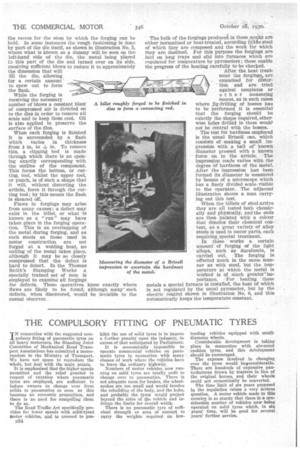THE COMPULSORY FITTING OF PNEUMATIC TYRES
Page 92

If you've noticed an error in this article please click here to report it so we can fix it.
IN connection with the suggested compulsory fitting of pneumatic tyres on all heavy motorcars, the Standing Joint Committee of Mechanical Road Transport Associations has submitted a memorandum to the Ministry of Transport. We have not space to reproduce the whole, but deal with the main points.
It is emphasized that the higher speeds permitted and the relief granted in respect of taxation where pneumatic tyres are employed, are sufficient to induce owners to change over from solids to pneumatics so soon as this becomes an economic proposition, and there is no need for compelling them to do so.
The Road Traffic Act specifically provides for lower speeds with solid-tyred motor vehicles, and to proceed to pro c34 hibit the use of solid tyres is to impose a Luther penalty upon the industry, in excess of that anticipated by Parliament.
It is economically impossible to Operate commercial vehicles on pneumatic tyres in connection with many classes of work where the ve,hicles have to leave the ordinary highway.
Numbers of motor vehicles now running on solid tyres are totally unfit to change over to pneumatics. There is not adequate room for brakes, the wheelarches are too small and would involve the rebuilding of the body, and the hubs, and probably the tyres would project beyond the sides of tae vehicle and infringe the limits for overall width.
There is no pneumatic tyre of sufficient strength or area of contact to carry the weights required on low
loading vehicles equipped with smalldiameter wheels.
Considerable development is taking place in connection with air-cored cushion tyres, and this de'Velopment should be encouraged.
The expense involved in changing over the tyres would be$cousiderable. There are hundreds of expensive pantechnicons drawn by tractors in lieu of the original horses, and their wheels could not economically be converted.
The time limit of six years proposed in the regulation raises a very serious question. A motor vehicle made in this country is so sturdy that there is a considerable number of vehicles now being operated OD solid tyres which, in six years' time, will be good for several years' further service.




















































































































































































